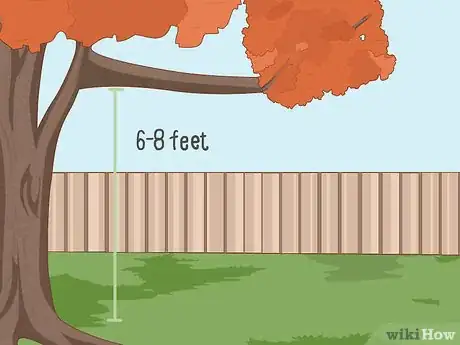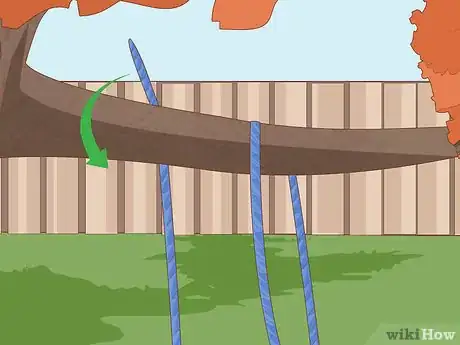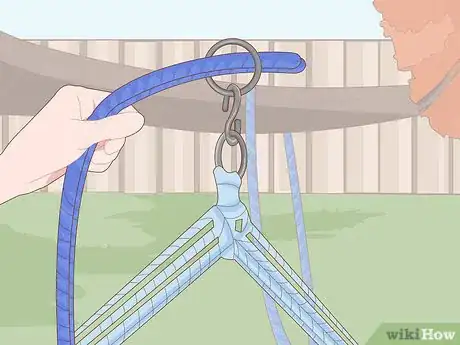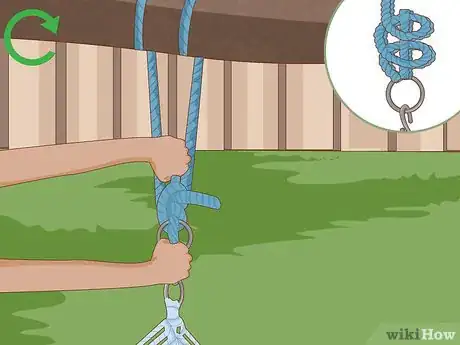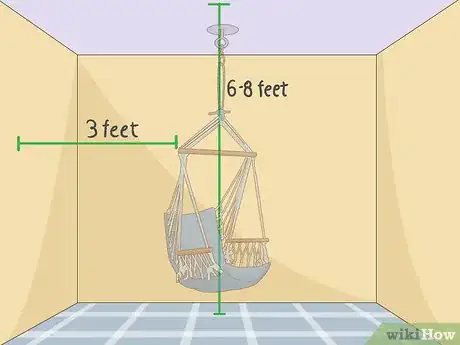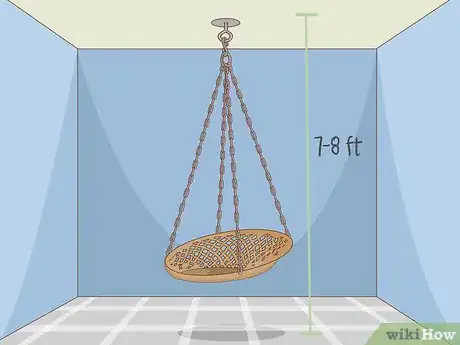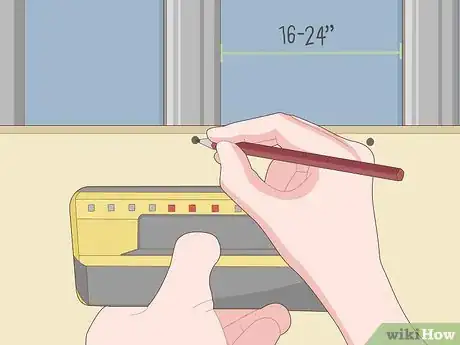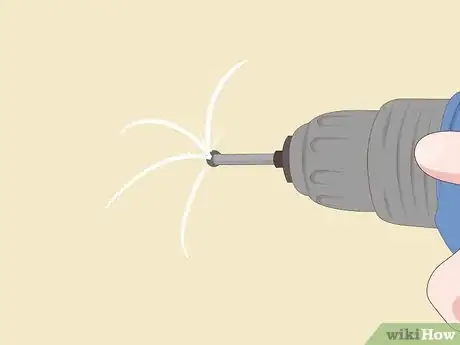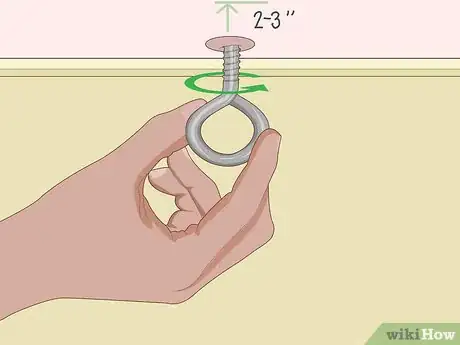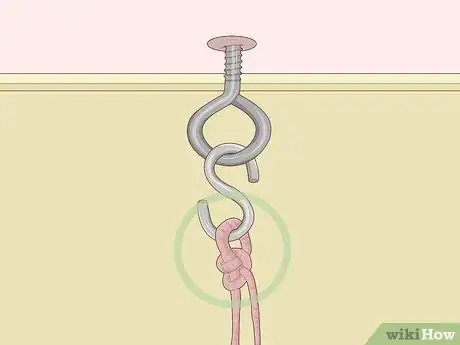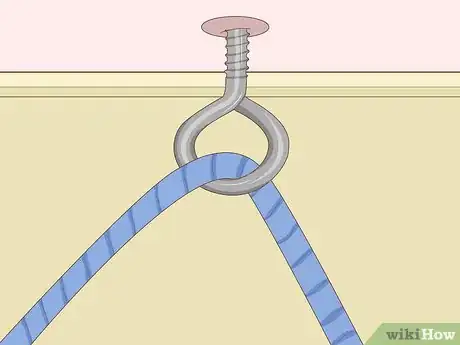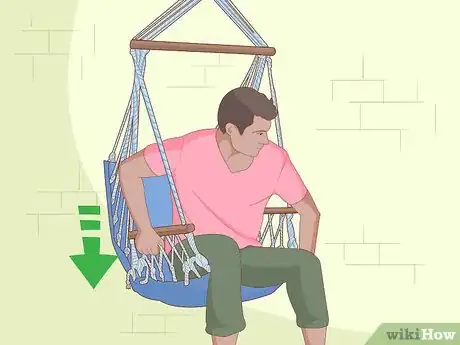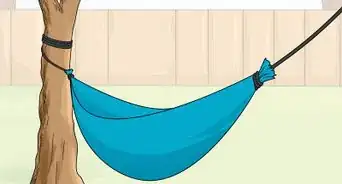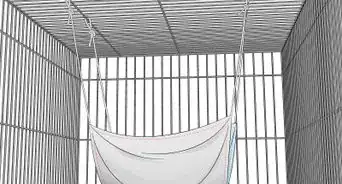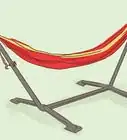This article was co-authored by Ryaan Tuttle. Ryaan Tuttle is a Home Improvement Specialist and the CEO of Best Handyman, Inc. in Boston, Massachusetts. With over 17 years of experience, he specializes in building home service businesses, focusing on creating scalable and efficient brands. With the help of his global team, the companies have achieved over 10+ million in sales and received recognition through magazine features, and enjoy partnerships with wikiHow and Jobber field service software. Boston Magazine and LocalBest.com have named Best Handyman Boston the Best Handyman in Boston. Ryaan holds Construction Supervisor and Home Improvement Contractor Licenses.
There are 8 references cited in this article, which can be found at the bottom of the page.
This article has been viewed 84,033 times.
Hammock chairs are the ultimate invitation to take a breather, and they can be installed nearly anywhere in and around your home. With the right tools, you can create a hanging oasis outside from a tree branch, or in your own bedroom. Once you know how to properly set up your hammock chair, you'll be able to relax at home in style and comfort.
Steps
Hanging the Chair Outdoors
-
1Pick a spot with at least 6 feet (1.8 m) of space from ground to hanging point. The most common spot will be a strong tree branch that can withstand significant weight (at least 250 pounds (110 kg)). A hardwood tree with healthy horizontal branches will provide the best support. Be sure your location offers 6 to 8 feet (1.8 to 2.4 m) of vertical clearance.
- Oak or maple trees are great hardwood trees to use.
- Check branches for any splitting or weak and worn points near the trunk.
- You can use a tape measure to figure out the diameter of your tree branch. Between 6 to 8 inches (15 to 20 cm) around should hold your hammock chair.
- Use a meter or yard stick to measure the distance between the ground and the tree branch. It won’t be exact, but it’ll give you a solid estimate.
- You can also hang your chair on an overhead beam in a gazebo or on your porch.
-
2Throw your rope over the branch or beam at least twice. Spread the rope on the branch to distribute weight. This prevents tension from settling at a single point, weakening that spot and increasing the risk of a break later.
- Make sure you have enough rope to accommodate height and the knots you’ll tie. With a 15 ft (4.6 m) rope, you’ll have plenty of slack for height adjustments, and you can cut off the excess.[1] However, you can probably get by with 7 feet (2.1 m) of rope.
Advertisement -
3Thread the rope ends through the hammock hanging mechanism. Your hammock chair might already have a reinforced loop, either directly on the chair, or at the end of a long rope or cord connected to it. Hold the rope ends in one hand and use the other to grasp the hammock loop. Slide the loop up, keeping the rope taut.[2]
- The hammock loop should sit right under the branch or beam.
-
4Knot the rope below the branch or beam with two half-hitch knots. Wrap the rope line on your left behind the rope line on your right. This forms a small loop beneath the branch. Insert the left rope line through this loop. Pull tight on the left rope. Then repeat, passing the left rope behind the right, then pushing through the new loop created.
- Pull the knots tight for a strong, tight hold. This ensures the hammock doesn’t fall when used.
- Use more knots for added security.
-
5Test the weight of the chair gradually. Pull on the hammock chair; use plenty of force to test its strength. If it holds, add more weight, like a stack of hefty books or several hand weights. Try to put about 50 pounds (23 kg) on the chair. After that, try lightly sitting on it yourself - or have someone else try. Slowly ease onto the chair until you’re fully seated. If it holds still, the chair is solid.[3]
Installing the Chair Indoors
-
1Choose an area with at least 6 feet (1.8 m) of vertical clearance and 3 feet (0.91 m) behind the chair. With 6 to 8 feet (1.8 to 2.4 m) of space from floor to ceiling, you’ll ensure there’s room for your chair to hang properly. The space behind the chair offers room for it to spin or sway.
- You can measure your space with a meter or yard stick. A tape measure also works.
- Survey the area so the hammock chair isn’t blocking or hitting anything nearby.
-
2Use rope for a classic way to hang your hammock chair. Rope is a popular choice, and with indoor use, it’ll last a long time. Rope also offers a beachy aesthetic that adds to the relaxing feeling of the hammock chair.
- Rope requires secure knots. Failing to use them risks damage to your home and could cause injury to whoever is using the hammock chair.[4] If knots are tricky, chains might be a better choice.
- Use rope with a working load of at least 200 to 250 pounds (91 to 113 kg) to ensure it can hold enough weight.
-
3Use chains to hang your chair with security. Chains provide enhanced sturdiness for your chair. Depending on the style of the chair or your home, they might not be as nice to look at. But you’ll know that chain won’t fray or break easily.
- Pre-measure your rope or chain so you have enough to attain the desired height. At least 7 feet (2.1 m) of rope will be sufficient for most needs, but if in doubt, it’s better to have more rope than less.
-
4Locate a ceiling joist with a stud finder. These tend to be installed 16 or 24 inches (41 or 61 cm) apart, so once you’ve found one, you can easily find more should that initial location not work. Use a stud finder, then mark both sides of the joist to find the center where you’ll drill.[5]
-
5Use a power drill to drill a pilot hole for the eye screw. The drill bit should be smaller than the eye screw’s width. The pilot hole should be roughly 2 to 3 inches (5.1 to 7.6 cm) deep and placed at your center mark.
- You’re in the right spot if you see wood shavings on the bit. That means you’ve hit solid wood.[8]
-
6Install the eye screw into the pilot hole. These screws should be long enough to twist at least 2 to 3 inches (5.1 to 7.6 cm) into the ceiling joists. Insert the eye screw, then turn it clockwise until it’s screwed in tightly. When it’s inserted fully, you shouldn’t see any visible threading on the screw.
- Ideally, the eye screw’s ring should touch the ceiling.
- Use a screwdriver to help tighten, if needed.
-
7Assemble your hanging chair with an S-hook. Link an S-hook to the eye screw. Next, attach your rope to the S-hook, knotting firmly with two half-hitch knots. At the chair’s attachment mechanism, knot again.[9]
- Chains can be hooked directly onto an S-hook, but you might need another hook or a locking carabiner at the chair’s attachment.
- Consider using stainless steel S-hooks in order to prevent damage and corrosion.[10]
-
8Hang your hammock chair by attaching rope directly to eye hooks.[11] Loop your rope through the eye screw. Tie tightly with two or more half-hitch knots. Weave the other end of the rope through the chair’s attachment and use another strong knot or two.
-
9Test the weight little by little. Pull firmly on the hammock chair. If it holds, add more weight, like a few heavy jugs or some thick books. Next, try lightly sitting on the chair yourself. Keep most of your weight on your legs as you squat over the chair, then slowly ease into the seat until you’re fully supported by it.[12]
References
- ↑ https://www.youtube.com/watch?v=51hF8e9puDQ&feature=youtu.be&t=104
- ↑ https://www.youtube.com/watch?v=51hF8e9puDQ&feature=youtu.be&t=80
- ↑ https://www.hammockuniverse.com/blogs/hammock-blog/diy-hammock-chair-installs-made-easy-humor-included
- ↑ https://www.hammockuniverse.com/blogs/hammock-blog/how-to-hang-a-hammock-indoors
- ↑ https://www.domino.com/content/how-to-install-hanging-chair/
- ↑ https://www.youtube.com/watch?v=G2bD0_XL3t4&feature=youtu.be&t=20
- ↑ https://swingsandthingssd.com/hammock-chair-care-tips/
- ↑ https://www.hammockuniverse.com/blogs/hammock-blog/how-to-hang-a-hammock-indoors
- ↑ https://www.domino.com/content/how-to-install-hanging-chair/
- ↑ Ryaan Tuttle. Home Improvement Specialist. Expert Interview. 24 September 2021.
- ↑ Ryaan Tuttle. Home Improvement Specialist. Expert Interview. 24 September 2021.
- ↑ https://www.hammockuniverse.com/blogs/hammock-blog/diy-hammock-chair-installs-made-easy-humor-included
About This Article
You can hang your hammock chair either indoors or outdoors as long as you have enough space and a sturdy support. If you’re hanging it outside, you’ll need a tree branch at least 6 inches in diameter and at least 6 feet off the ground to ensure it can hold your weight. You’ll need to wrap a rope a few times around the branch and attach it to your chair’s hanging mechanism. To hang it indoors, you’ll need to use a stud finder or magnet to locate a ceiling joist. Alternatively, you can hang your chair from an exposed beam. Screw an eye screw into your joist or beam and hang your chair with rope or chains. It’s important to always test the weight of your chair before you sit in it. Try pulling on the seat, then sitting carefully in it while keeping your feet planted to make sure it's safe. For more tips, including how to tie a half-hitch knot to support your hammock chair, read on!
